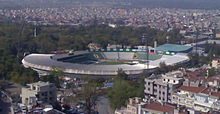|
2013 FIFA U-20 World Cup
 The 2013 FIFA U-20 World Cup was the nineteenth edition of the FIFA U-20 World Cup, since its inception in 1977 as the FIFA World Youth Championship. It ran from 21 June to 13 July 2013. At the FIFA Executive Meeting in Zürich on 3 March 2011, Turkey beat other bids to host the series games, from host competition by the United Arab Emirates and Uzbekistan.[1] In its bid, Turkey suggested the use of thirteen stadiums in ten of its cities,[2] before deciding in February 2012, that seven cities would play host to games.[3] This tournament marked the first time in its history that neither Argentina nor Brazil (the most successful teams in the competition) qualified. It was also only the second time that Brazil had not taken part (the first time was the 1979 edition). France won the tournament and their first U-20 World Cup, and thus became the first nation to win all five FIFA 11-a-side men's titles (FIFA World Cup, FIFA Confederations Cup, FIFA U-20 World Cup, FIFA U-17 World Cup, and the Olympic football tournament).[4][5] BidsAt the deadline date of 17 January 2011, three member associations confirmed they would be bidding for the event.[6] Neither Turkey nor Uzbekistan had ever been hosts to a FIFA competition, while the United Arab Emirates were hosts of the U-20s in 2003.
VenuesQualificationIn addition to host nation Turkey, 23 nations qualified from six separate continental competitions.
Organization and emblemTo mark the one year countdown date to the competition, FIFA, as well as members of the Turkish FA, announced that the emblem would be presented to the media on 25 June 2012 at Ciragan Palace Mabeyn Hall in Istanbul.[8] Details of the ticketing access were made publicly available on 30 November 2012.[9][10] Host city logos for each participating stadium were shown to the general public on 20 March 2013, with each taking inspiration from their surroundings.[11] The official logo included an Evil Eye protector, worn or hung inside Turkish homes to bring luck.[12] MascotThe mascot for the tournament was called Kanki, a blue-eyed Kangal puppy.[13] Theme songThe official theme song for the tournament was Yıldızlar Buradan Yükseliyor, which is translated as Building Bridges for Rising Stars, performed by Turkish rock band Gece.[14][15] DrawThe final draw was held at the Grand Tarabya Hotel in Istanbul on 25 March 2013, at 19:00 local time.[16] On 12 February 2013, FIFA announced the procedure of the draw. The 24 teams were divided into four differing pots:[17]
Turkey was assigned to position C1, and Spain was assigned to Group A. As a basic principle, teams from the same confederation could not be drawn against each other at the group stage, except in Group A where there were two teams from UEFA. As the CAF U-20 Championship was not completed at the time of the draw, a separate draw took place at the tournament's conclusion on 30 March in Oran, Algeria to determine the groups where the second, third and fourth-placed CAF teams would play in.[18][19] As the OFC U-20 Championship was realize after at time of the draw, New Zealand appeared in Pot 1 as OFC Champion.[20]
Match officialsThe 23 referee trios were announced by FIFA on 13 May 2013.[21][22]
SquadsTeams had to name a 21-man squad (three of whom had to be goalkeepers) by the FIFA deadline. The squads were announced by FIFA on 14 June 2013.[23][24] Group stageThe winners and runners-up from each group, as well as the best four third-placed teams, qualified for the first round of the knockout stage (round of 16).[25] The ranking of each team in each group was determined as follows:
If two or more teams were equal on the basis of the above three criteria, their rankings were determined as follows:
All times are local, UTC+03:00.[26] Group A
Source: [citation needed]
Group B
Source: [citation needed]
Group C
Source: [citation needed]
Group D
Source: [citation needed] Notes:
Group E
Source: [citation needed]
Group F
Source: [citation needed]
Ranking of third-placed teamsThe four best teams among those ranked third were determined as follows:[25]
Source: [citation needed]
Knockout stageIn the knockout stages, if a match was level at the end of normal playing time, extra time was played (two periods of fifteen minutes each) and followed, if necessary, by a penalty shoot-out to determine the winner, except for the play-off for third place, where no extra time would be played as the match was played directly before the final.[25]
Round of 16
Quarter-finals
Semi-finals
Third place matchFinal
AwardsThe following awards were given out after the conclusion of the tournament:[27]
GoalscorersWith six goals, Ebenezer Assifuah is the top scorers in the tournament. In total, 152 goals were scored by 99 different players, with one of them credited as own goals.
Final ranking
MiscellaneaTrophyThe winners were the first team to receive an updated version of the trophy,[28] with Rebecca Cusack and Thomas R. Fattorini of Thomas Fattorini Ltd, Birmingham taking over from Sawaya & Moroni [29] as suppliers of FIFA competitions. Vanishing sprayA “vanishing spray” made its FIFA debut (versions were already in use in CONCACAF and CONMEBOL competitions) during this tournament, with referees using it to denote the ten-yard mark for an opposing defence at time of free kicks.[30] Media coverageLatin America
AsiaEuropeReferences
External linksWikimedia Commons has media related to FIFA U-20 World Cup 2013.
|
|||||||||||||||||||||||||||||||||||||||||||||||||||||||||||||||||||||||||||||||||||||||||||||||||||||||||||||||||||||||||||||||||||||||||||||||||||||||||||||||||||||||||||||||||||||||||||||||||||||||||||||||||||||||||||||||||||||||||||||||||||||||||||||||||||||||||||||||||||||||||||||||||||||||||||||||||||||||||||||||||||||||||||||||||||||||||||||||||||||||||||||||||||||||||||||||||||||||||||||||||||||||||||||||||||||||||||||||||||||||||||||||||||||||||||||||||||||||||||||||||||||||||||||||||||||||||||||||||||||||||||||||||||||||||||||||||||||||||||||||||||||||||||||||||||||||||||||||||||||||||||||||||||||||||||||||||||||||||||||||||||||||||||||||||||||||||||||||||||||||||||||||||||||||||||||||||||||||||||||||||||||||||||||||||||||||||||||||||||||||||||||||||||||||||||||||||||||||||||||||||||||||||||||||||||||||||||||||||||||||||||||||||||||||||||||||||||||||||||||||||||||||||||||||||||||||||||||||||||||||||||||||||||||||||||||||||||||||||||||||||||||||||||||||||||||||||||||||||||||||






